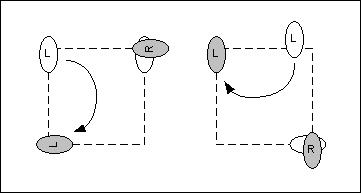Taekwondo tul (forms) are not just a series of poses with little or no importance placed on the transition between them. Whether your technique is effective is as much a function (if not more) of the transition than the final state. Consider a head block: Most beginners can tell you about where your hand goes, the angle of your arm, the distance from your head, etc. That's only part of the story, though. If a fist is coming straight at your face, it'll do you no good to end up in a perfect pose if your "block" swings up from the side and doesn't deflect the punch.
The same concept applies to stances. How you transition from one stance to the next can have a profound impact on the amount of power you can put into your technique. Let's take two common examples: The very first move of Chon-Ji tul and the common shift from back ("L") stance to front ("walking") stance. These are shown below.

The left and right feet are marked with an "L" and "R" respectively and the filled-in feet are the final positions. The dotted box is a square the length of your shoulder width on each side. In the left example, the left foot moves in a little and then back out to a proper front stance. The right foot merely pivots on the ball. The right example is similar; the left (front) foot moves and the right (back) foot pivots. Why?
Power, in the martial arts sense, is a function of momentum. When you move your front foot, your weight is momentarily supported entirely by your back foot. When you drop your weight into your stance and technique, it is going forward and contributing to the power of your technique. If you move your back foot, then your weight (and power) is going backward. Of course, if you move both feet, then the majority of your weight is going straight down.
It can take decades to perfect the little nuances of movement and timing that lead to power, but you'll be starting out in a hole if you don't transition from one stance to the next properly. The next time you practice your forms consider how you move your feet, because getting there is half the power.